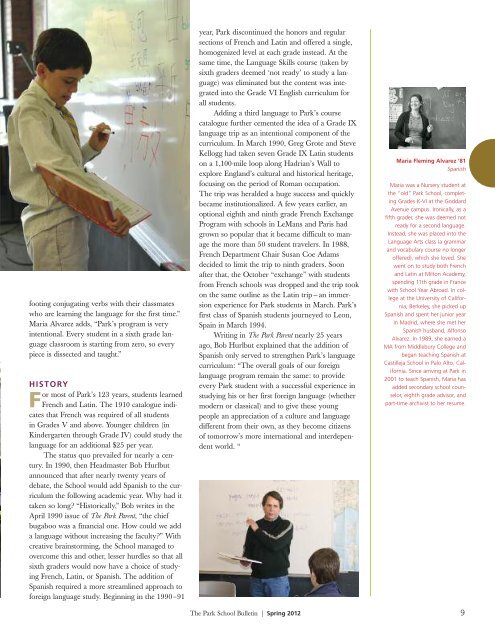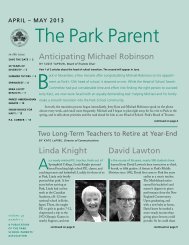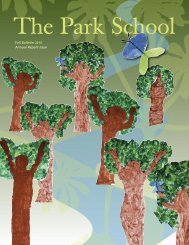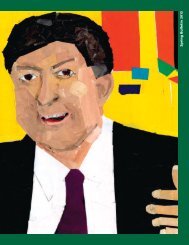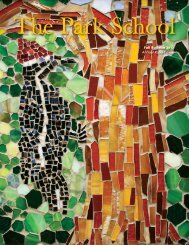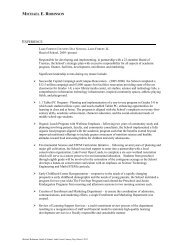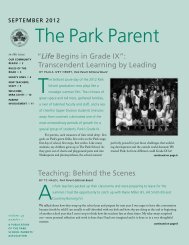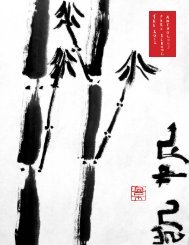Spring Bulletin 2012 - The Park School
Spring Bulletin 2012 - The Park School
Spring Bulletin 2012 - The Park School
Create successful ePaper yourself
Turn your PDF publications into a flip-book with our unique Google optimized e-Paper software.
footing conjugating verbs with their classmates<br />
who are learning the language for the first time.”<br />
Maria Alvarez adds, “<strong>Park</strong>’s program is very<br />
intentional. Every student in a sixth grade language<br />
classroom is starting from zero, so every<br />
piece is dissected and taught.”<br />
HISTORY<br />
or most of <strong>Park</strong>’s 123 years, students learned<br />
F<br />
French and Latin. <strong>The</strong> 1910 catalogue indicates<br />
that French was required of all students<br />
in Grades V and above. Younger children (in<br />
Kindergarten through Grade IV) could study the<br />
language for an additional $25 per year.<br />
<strong>The</strong> status quo prevailed for nearly a century.<br />
In 1990, then Headmaster Bob Hurlbut<br />
announced that after nearly twenty years of<br />
debate, the <strong>School</strong> would add Spanish to the curriculum<br />
the following academic year. Why had it<br />
taken so long? “Historically,” Bob writes in the<br />
April 1990 issue of <strong>The</strong> <strong>Park</strong> Parent, “the chief<br />
bugaboo was a financial one. How could we add<br />
a language without increasing the faculty?” With<br />
creative brainstorming, the <strong>School</strong> managed to<br />
overcome this and other, lesser hurdles so that all<br />
sixth graders would now have a choice of studying<br />
French, Latin, or Spanish. <strong>The</strong> addition of<br />
Spanish required a more streamlined approach to<br />
foreign language study. Beginning in the 1990–91<br />
year, <strong>Park</strong> discontinued the honors and regular<br />
sections of French and Latin and offered a single,<br />
homogenized level at each grade instead. At the<br />
same time, the Language Skills course (taken by<br />
sixth graders deemed ‘not ready’ to study a language)<br />
was eliminated but the content was integrated<br />
into the Grade VI English curriculum for<br />
all students.<br />
Adding a third language to <strong>Park</strong>’s course<br />
catalogue further cemented the idea of a Grade IX<br />
language trip as an intentional component of the<br />
curriculum. In March 1990, Greg Grote and Steve<br />
Kellogg had taken seven Grade IX Latin students<br />
on a 1,100-mile loop along Hadrian’s Wall to<br />
explore England’s cultural and historical heritage,<br />
focusing on the period of Roman occupation.<br />
<strong>The</strong> trip was heralded a huge success and quickly<br />
became institutionalized. A few years earlier, an<br />
optional eighth and ninth grade French Exchange<br />
Program with schools in LeMans and Paris had<br />
grown so popular that it became difficult to manage<br />
the more than 50 student travelers. In 1988,<br />
French Department Chair Susan Coe Adams<br />
decided to limit the trip to ninth graders. Soon<br />
after that, the October “exchange” with students<br />
from French schools was dropped and the trip took<br />
on the same outline as the Latin trip — an immersion<br />
experience for <strong>Park</strong> students in March. <strong>Park</strong>’s<br />
first class of Spanish students journeyed to Leon,<br />
Spain in March 1994.<br />
Writing in <strong>The</strong> <strong>Park</strong> Parent nearly 25 years<br />
ago, Bob Hurlbut explained that the addition of<br />
Spanish only served to strengthen <strong>Park</strong>’s language<br />
curriculum: “<strong>The</strong> overall goals of our foreign<br />
language program remain the same: to provide<br />
every <strong>Park</strong> student with a successful experience in<br />
studying his or her first foreign language (whether<br />
modern or classical) and to give these young<br />
people an appreciation of a culture and language<br />
different from their own, as they become citizens<br />
of tomorrow’s more international and interdependent<br />
world. “<br />
Maria Fleming Alvarez ’81<br />
Spanish<br />
Maria was a Nursery student at<br />
the “old” <strong>Park</strong> <strong>School</strong>, completing<br />
Grades K-VI at the Goddard<br />
Avenue campus. Ironically, as a<br />
fifth grader, she was deemed not<br />
ready for a second language.<br />
Instead, she was placed into the<br />
Language Arts class (a grammar<br />
and vocabulary course no longer<br />
offered), which she loved. She<br />
went on to study both French<br />
and Latin at Milton Academy,<br />
spending 11th grade in France<br />
with <strong>School</strong> Year Abroad. In college<br />
at the University of California,<br />
Berkeley, she picked up<br />
Spanish and spent her junior year<br />
in Madrid, where she met her<br />
Spanish husband, Alfonso<br />
Alvarez. In 1989, she earned a<br />
MA from Middlebury College and<br />
began teaching Spanish at<br />
Castilleja <strong>School</strong> in Palo Alto, California.<br />
Since arriving at <strong>Park</strong> in<br />
2001 to teach Spanish, Maria has<br />
added secondary school counselor,<br />
eighth grade advisor, and<br />
part-time archivist to her resume.<br />
<strong>The</strong> <strong>Park</strong> <strong>School</strong> <strong>Bulletin</strong> | <strong>Spring</strong> <strong>2012</strong> 9


